Fujifilm XF 50mm f1.0 review
-
-
Written by Gordon Laing
Intro
The Fujifilm XF 50mm f1.0 is a very bright prime lens for X-series mirrorless cameras, upon which it delivers short telephoto coverage that’s ideal for portraits. Announced in September 2020, it’s the first f1.0 lens for mirrorless cameras with autofocus, and a model that’s been under development for some time. Fujifilm initially planned to make a 33mm f1.0 lens, teasing it as far back as mid-2018, but a year later announced the design had switched to a 50mm f1.0 due to the original becoming too cumbersome. So taking the sensor field-reduction into account, it’s gone from delivering standard coverage to become a short telephoto.
Either way, it’s finally arrived and I’ve now completed my full review with in-depth comparisons between it and the earlier XF 50mm f2 and XF 56mm f1.2 models, and as you’ll discover, each has their pros and cons! My full review is split into two parts, first there’s my in-depth optical comparison video which pitches final production samples against each other. This is below, followed by my original first-looks preview video for anyone who wants to learn more about their physical side. And as always, the videos are followed by written highlights for those who prefer to read. There’s also my usual page of sample images and my final verdict page!
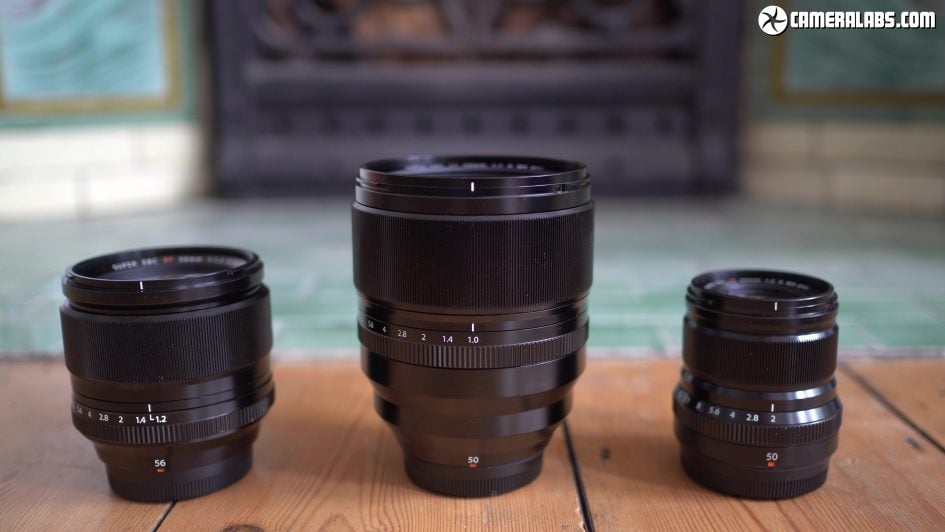
Above: The Fujifilm XF 50mm f1.0 joins two existing prime lenses of a similar length in the X series. There’s the XF 50mm f2 on the right, two whole stops slower, but considerably smaller, a quarter of the weight, roughly one third the price and still weather-sealed. Alternatively there’s the XF 56mm f1.2 on the left, sadly lacking weather-sealing, but still half the weight, two thirds the price and only giving up half a stop in aperture.
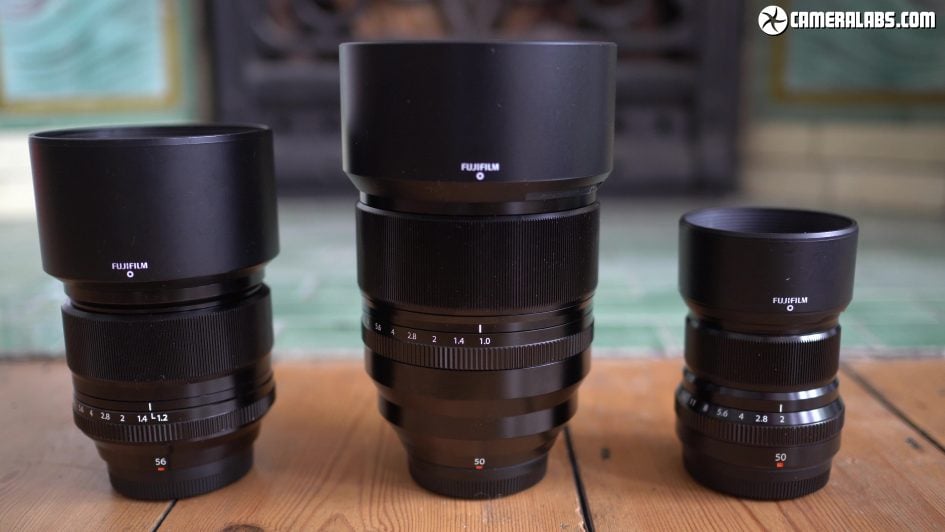
Above: Here they are with their supplied lens hoods. So the major differences to consider are size, weight, maximum aperture and of course price. I remember when the 56mm was the only lens of this length in the X catalogue, so it’s great to now have a choice of three at different price points.
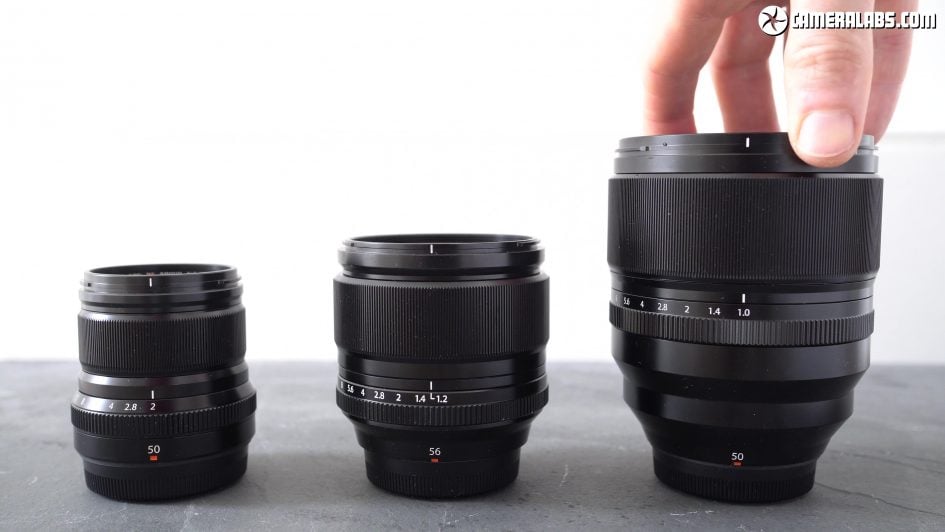
Above: The XF 50mm f1.0 is clearly the heftiest of the bunch, measuring 87mm in diameter, 104mm long and weighing 845g. Again that’s double the weight of the XF 56mm f1.2 and four times that of the XF 50mm f2, so you’ll certainly know you’re carrying it around.
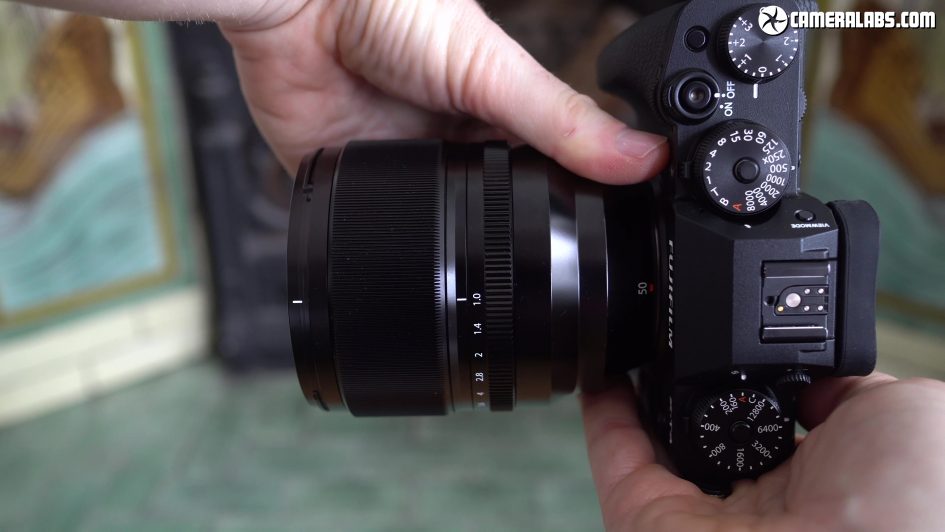
Above: As one of the larger and heavier lenses in the system, it’s best-suited to the larger bodies, in particular the single-digit XT models. I tested it on the X-T4 where it felt surprisingly well-balanced even without the battery grip, but I wouldn’t personally recommend it on one of the smaller bodies.
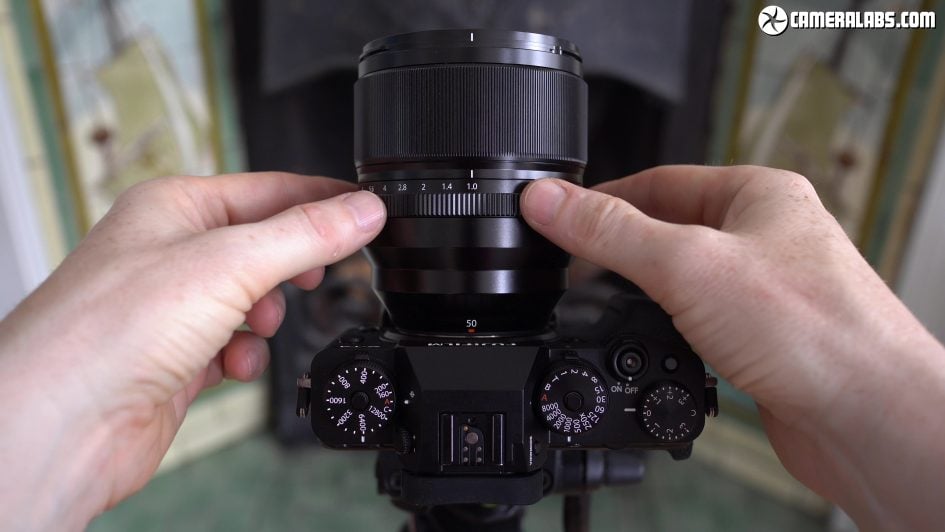
Above: There’s just two controls: a clicky aperture ring with the usual A position for body control if preferred. I like having manual aperture rings, but would prefer Fujifilm to adopt a barrel switch to temporarily declick it for silent and smooth operation as seen but not heard on a number of Sony lenses. Meanwhile there’s a generously sized manual focusing ring which is motor-assisted – there’s no clutch mechanism of some of Fujifilm’s wider primes. The manual focusing ring turns freely, but covers the minimum focusing distance of 70cm to infinity in a generous 120 degree arc, allowing small and precise adjustments, although beware the focusing motors will be audible if you’re using the built-in mics.
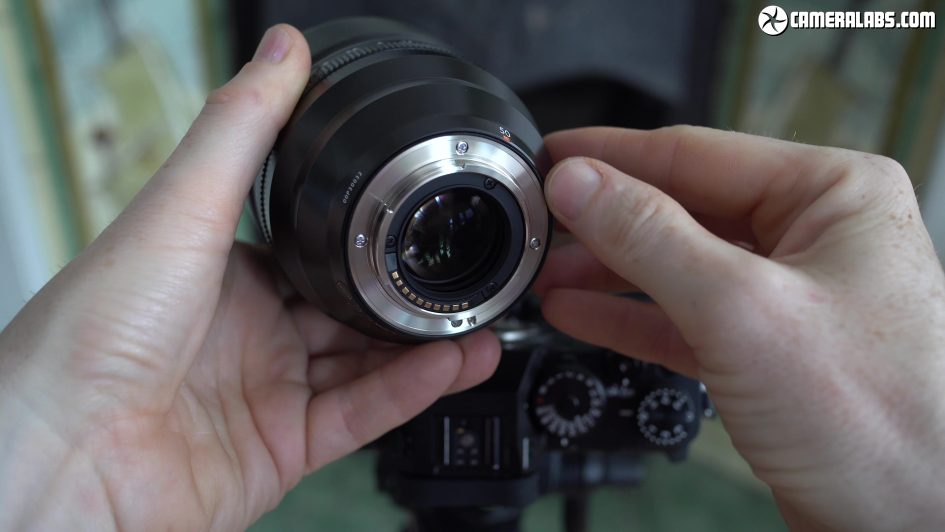
Above: The lens is dust and weather-sealed in ten places, including a rubber grommet on the mount. This is a key benefit it has over the XF 56mm f1.2 which was designed back when Fujifilm annoyingly neglected weather sealing on many lenses. As I noted earlier though, the much more affordable XF 50mm f2 also includes weather-sealing, as indicated by WR in the full model name.
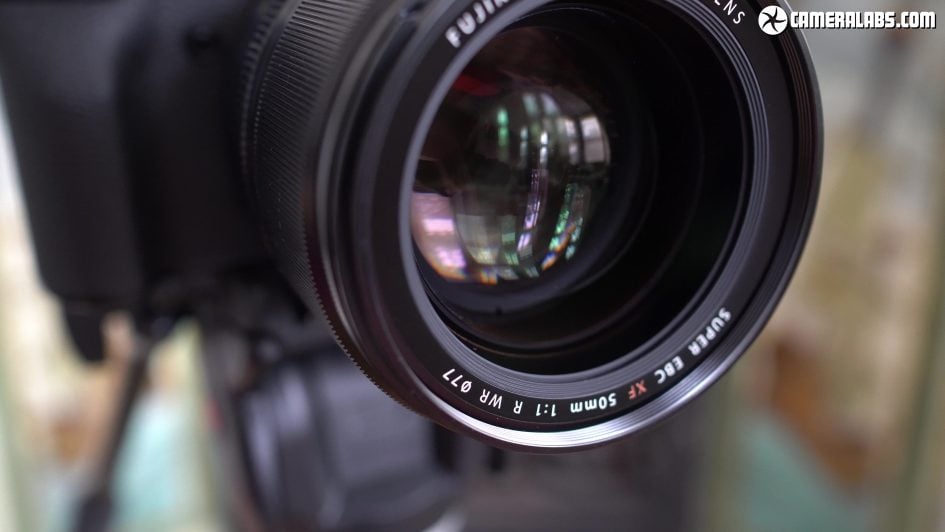
Above: The optics consist of 12 elements in nine groups including one aspherical and two ED elements. The most exciting part is of course that large front element, unusually featuring a concave shape. You’ll need 77mm filters versus 62mm for the XF 56mm or 46mm on the XF 50mm f2.
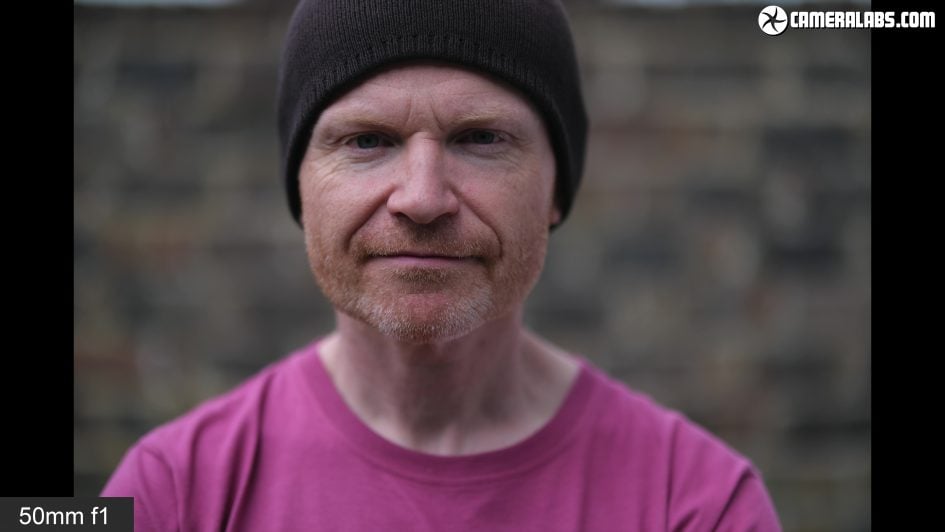
Above: Mount the 50mm on an X-series body and their APSC sensors reduce the field of view to 75mm equivalent, making it a very short telephoto, ideal for close-range portraits, while the f1.0 focal ratio allows for very shallow depth-of-field effects. In full-frame terms, the XF 50mm f1.0 becomes equivalent to 75mm f1.5 in terms of coverage and depth-of-field. Arguably the closest models for comparison would be full-frame 85mm f1.4 lenses, although in practice the 10mm difference in focal length gives them a different feel. Here’s some portrait shots of yours-truly, taken with a pre-production XF 50mm f1.0 of course set to f1.0 on a Fujifilm X-T4 body. Face-on at f1.0 at this distance, my eyes are sharp but the extremely shallow depth-of-field has already blurred my rear jawline and earlobes, while the brick wall only a couple of meters behind me has become quite blurred.
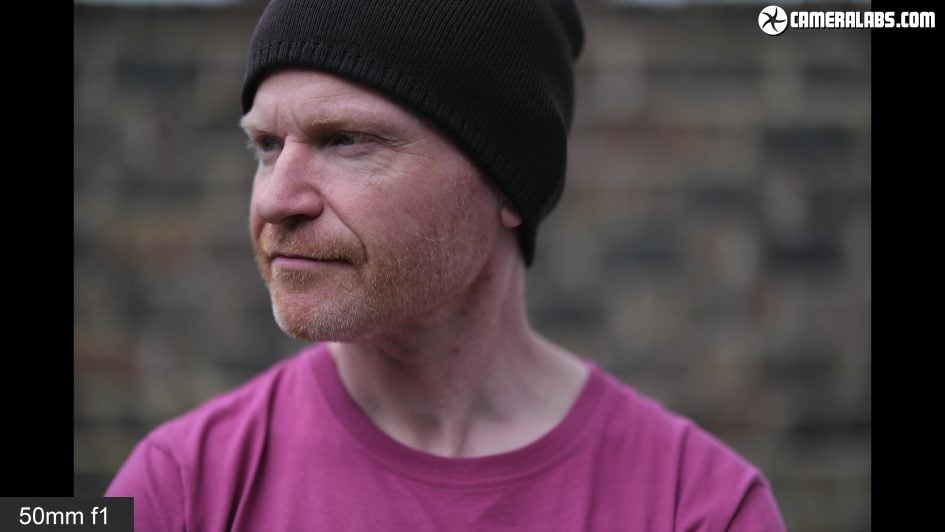
Above: In the mid-profile shot, the closest eye is sharp, but the rear eye is unsurprisingly blurred. It’s certainly dramatic shooting portraits at this kind of aperture, but may or may not be to your taste.
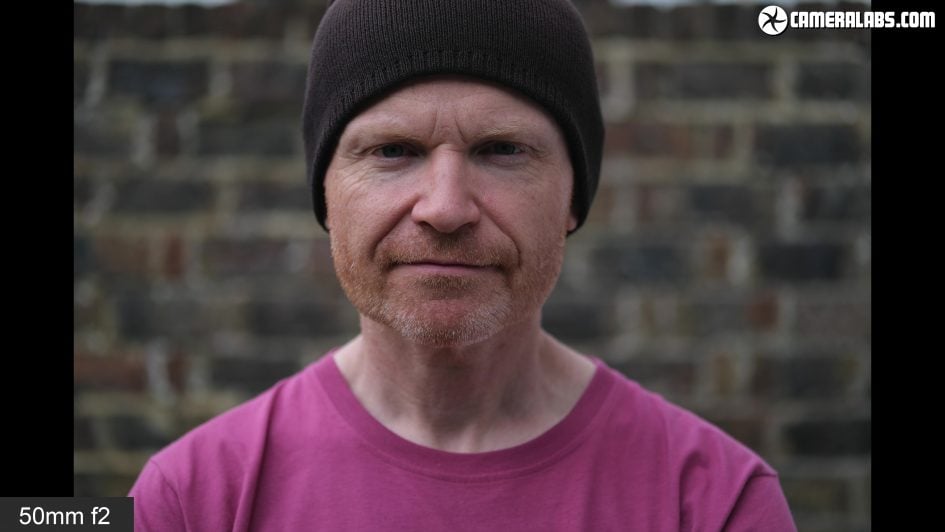
Above: For comparison, here’s the XF 50mm f2, wide-open at f2, where at first glance the most obvious difference is the less blurry wall, which again may or may not be preferable depending on the subject separation you desire.
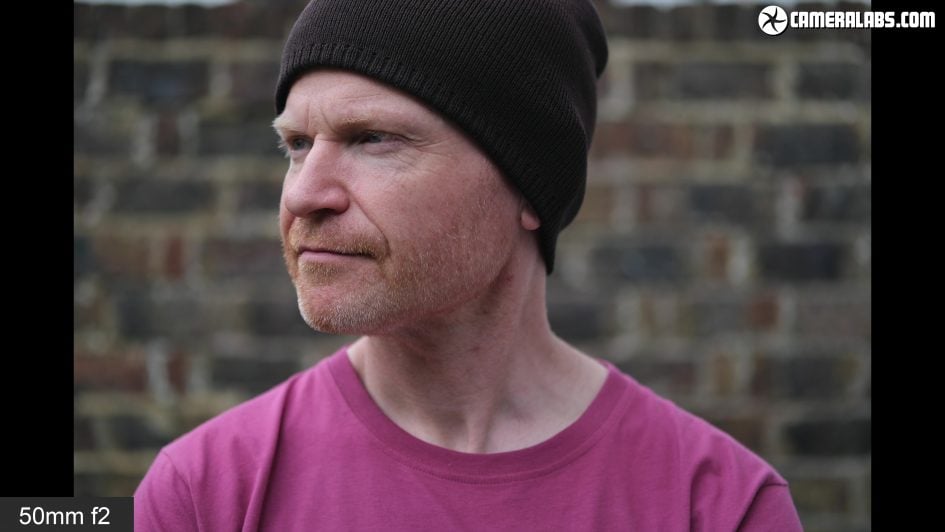
Above: In the meantime, the broader depth-of-field has ensured more of my actual head is in focus and while I’m not allowed to make a zoomed-in comparison yet, I’m always impressed by the sharpness of this little lens.
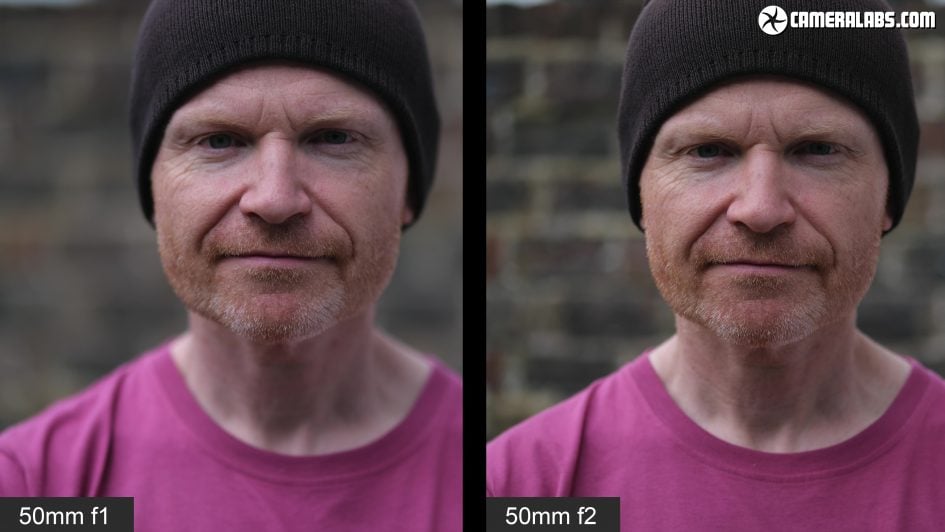
Above: Here they are side-by-side with the XF 50mm f1 on the left at f1 and the XF 50mm f2 on the right at f2. Neither have been enlarged, so you’re looking at the full image height.
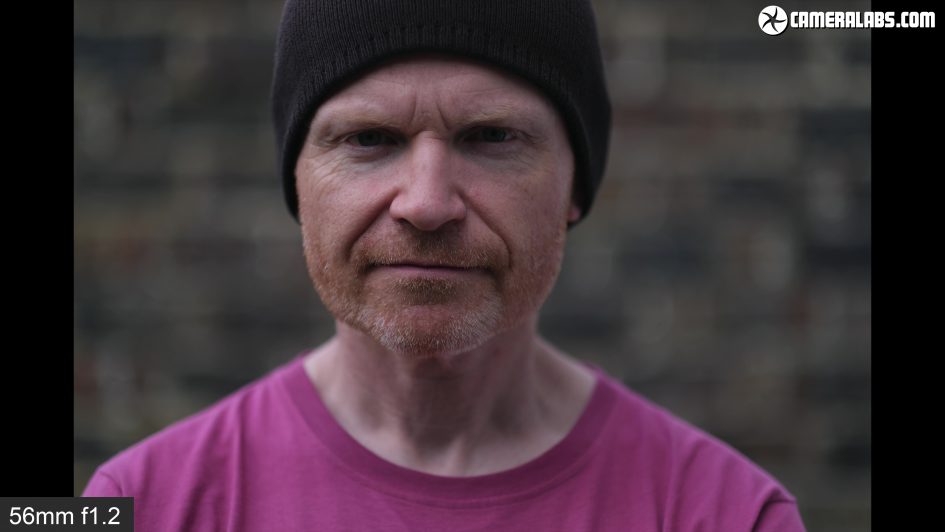
Above: For my next comparison, here’s the XF 56mm f1.2 wide-open at f1.2. I shot this from the same distance where the slightly longer focal length of the 56mm is delivering a slightly tighter view.
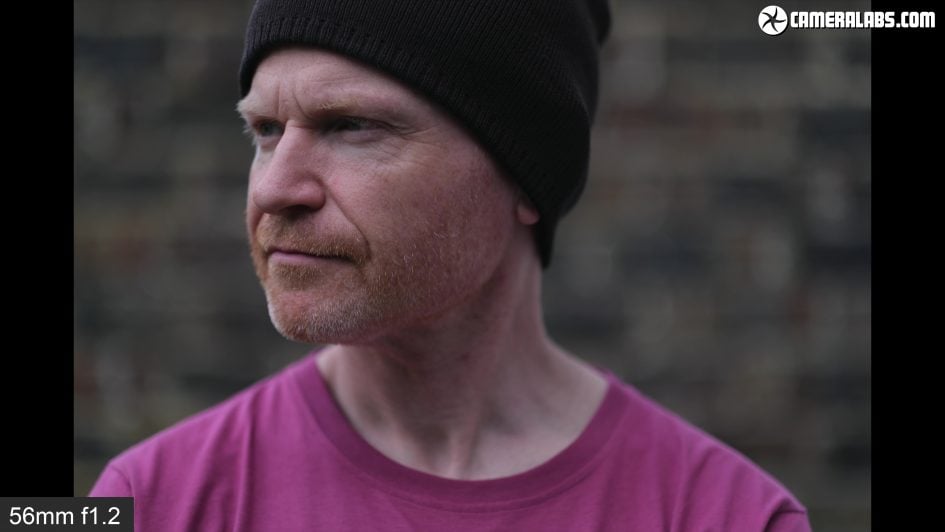
Above: Here’s the profile shot from the same position. To match the subject size and background area of these lenses, I would need to move the camera back, but unfortunately my garden wall prevented that, so instead I’ll shuffle backwards a little for the next comparison. The change in subject distance will impact the depth of field, so bear that in mind.
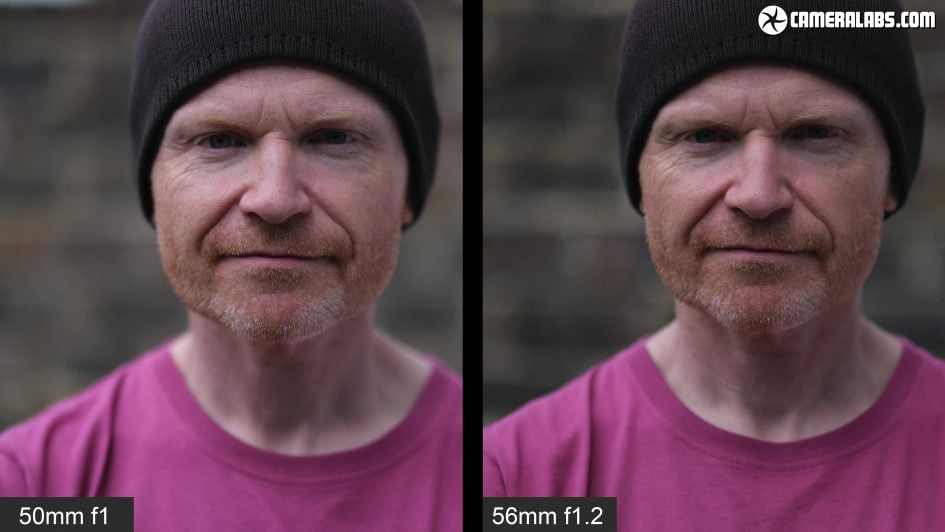
Above: So here’s the XF 50mm f1.0 on the left and the XF 56mm f1.2 at f1.2 with me standing a little further back. As you’d expect given the difference in aperture and subject distance, the XF 56mm f1.2 is delivering a less shallow depth-of-field, but not by much.

Above: And now the profile comparison. Despite missing out on weather-sealing, it remains one of my favourite portrait lenses, able to deliver a lot of blurring from a lens that remains fairly compact.
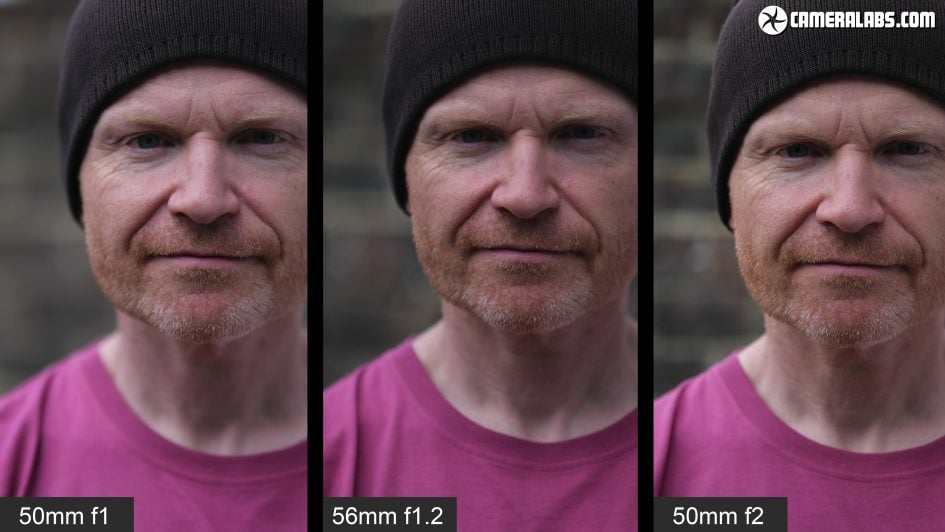
Above: And finally, here’s all three lenses side-by-side, starting with the XF 50mm f1 on the left, the XF 56mm f1.2 in the middle and the XF 50mm f2 on the right, all at their maximum apertures and all with the subject size roughly matched. Obviously the larger aperture lenses are delivering a shallower depth-of-field, but which do you actually prefer the look of?
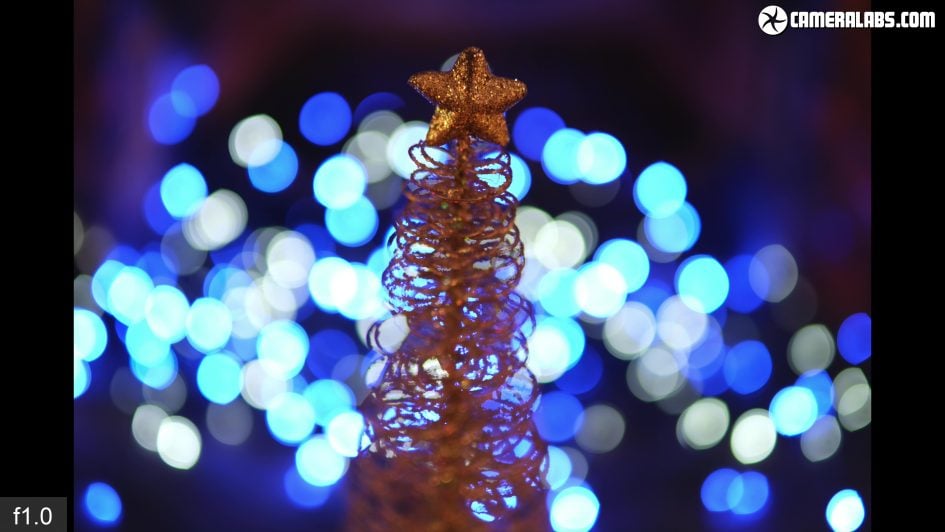
Above: Moving on, the rendering of point of sources of light into so-called bokeh blobs is an important capability of large aperture lenses, so for my next test I photographed this ornament in front of some LED fairy lights. The XF 50mm f1 and 56mm f1.2 both share the same minimum focusing distance of 70cm versus 39cm for the 50mm f2, so for this first comparison I shot with them all from the same distance – but I will show you the 50mm f2 from its closer distance afterwards. Oh and since everything was shot at 70cm away, the 56mm will show a slightly tighter view due to its slightly longer focal length. Wide-open, there’s the familiar cats-eye rugby ball shape from the XF 50mm f1.0 towards the edges, although this decreases quickly and by around f1.4 the blobs become more circular. The style of rendering, at least from this pre-production sample, is for softer edges which makes for a less distracting, less busy background.
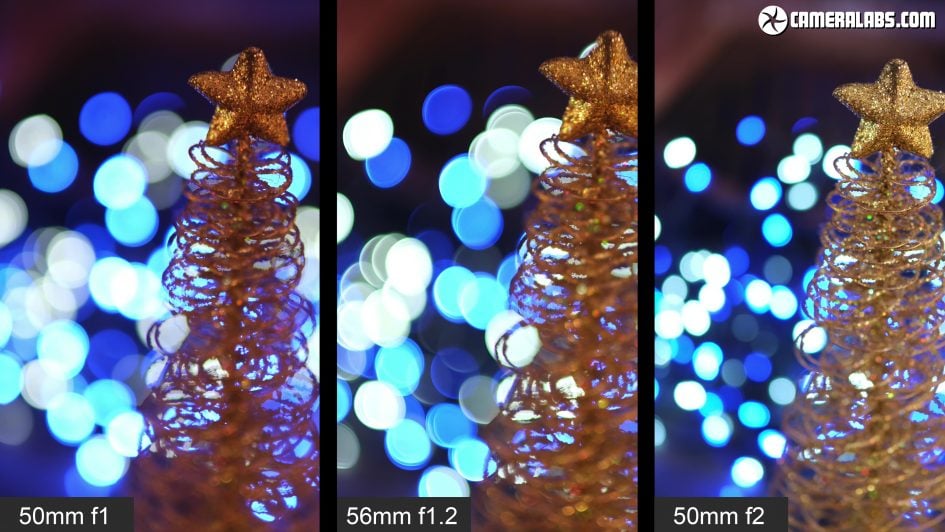
Above: Now for all three lenses, side by side with the 50mm f1 on the left, the 56mm f1.2 in the middle and the 50mm f2 on the right, all wide-open and from the same distance. The first thing you’ll notice is the smaller size of the blobs from the 50mm f2 on the right, a limitation of its smaller aperture. But look at the differences in the style of the rendering, in particular between the 50mm f1 and 56mm f1.2, where the 56mm renders much sharper edges to its blobs, often with a distracting lining as a result. Obviously rendering and bokeh is an entirely personal choice, so I’d be very interested to hear which lens you prefer here, but the 50mm f1 is certainly less harsh than the 56 here. I should however mention Fujifilm also offers an APD version of the 56mm which renders softer bokeh effects, although it’s priced the same as the 50mm f1.
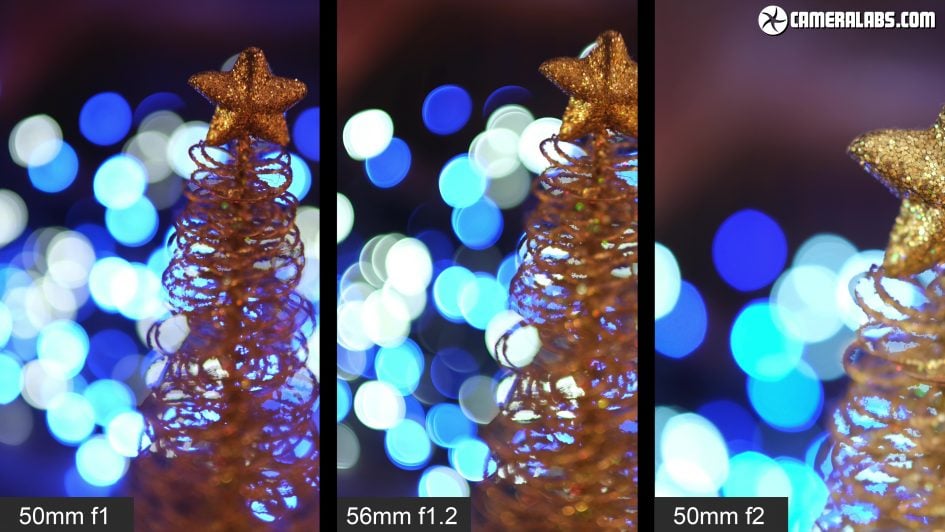
Above: But wait, as mentioned earlier, the cheaper XF 50mm f2 can focus much closer than the other two lenses, in fact almost twice as close, so I’ve switched the previous image at 70cm for one taken at its minimum focusing distance, quoted as 39cm. Obviously this makes both the subject and the blobs bigger than before, and now its has the biggest blobs of all three lenses, plus while the rendering isn’t as smooth as the 50mm f1, it still avoids the sharp edges of the 56mm, at least in the standard non-APD version. As an aside, it’s actually the smaller aperture of the 50mm f2 that allows its closer focusing distance as larger aperture lenses suffer from increased field curvature at close distances, hence the limit on the f1 and f1.2 models.
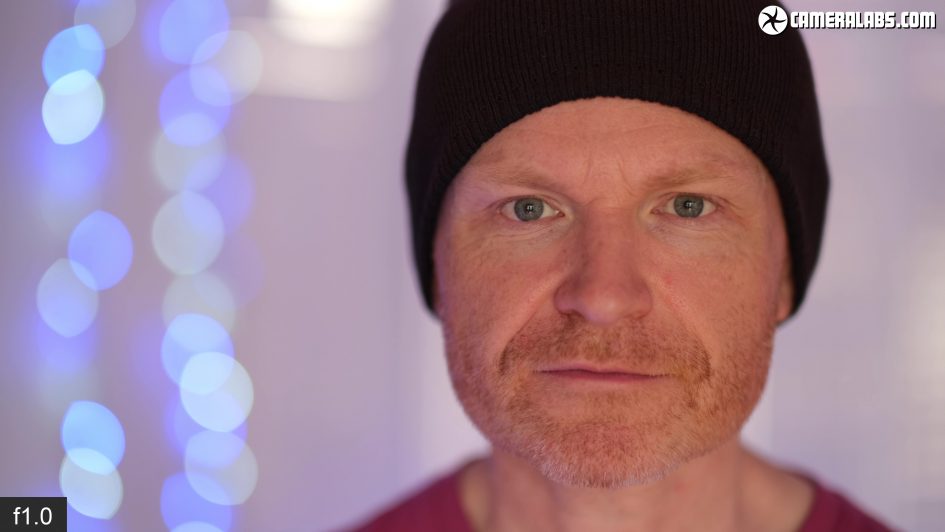
Above: Everything that makes the lens great for photos also applies to video, and I found it especially fun to present pieces to camera with that very shallow depth-of-field. The X-T4 successfully refocused on me as I moved back and forth, although sometimes took a moment to catch up. As such it’s not as responsive as using, say, the Canon RF 50mm f1.2 or 85mm f1.2 on an EOS R body. Note the lens focusing is quite audible. To be fair it has a lot of elements to move, but if you’re filming a piece to camera, be sure to use an external, or ideally a lav mic. On the plus side, there’s minimal focus breathing to worry about.
Check prices on the Fujifilm XF 50mm f1.0 at B&H, Adorama or WEX! Alternatively get yourself a copy of my In Camera book or treat me to a coffee! Thanks!
 The Fujifilm XF 50mm f1.0 is a very bright prime lens for X-series mirrorless cameras, upon which it delivers short telephoto coverage that’s ideal for portraits. In my tests, it delivered sharp details into the corners even at f1 so long as they fell within its razor thin depth-of-field. The rendering was also attractive, capable of obliterating backgrounds and avoiding busy bokeh. What’s not to like? Assuming you’re okay with the price and the heft that will limit it mostly to X-T owners, I’d prefer Fujifilm to use de-clickable aperture rings, and I’d have also found it more flexible with closer focusing, although I appreciate that’s difficult on large aperture lenses. I also like the positioning of the three similar focal lengths in the X series at roughly $500 intervals, so Fuji-owners have something compelling at a variety of price points. I think the 50mm f2 represents really good value at the affordable-end with sharp results and enough blurring for most people, with the added benefit of closer focusing. If I already owned the 56 1.2 or couldn’t budget beyond it, I’d be happy to stick with that model, but if I was investing in my first large aperture portrait lens for an X-series body, I’d try hard to stretch to the 50mm f1. It’s a gorgeous lens and I loved shooting with it.
The Fujifilm XF 50mm f1.0 is a very bright prime lens for X-series mirrorless cameras, upon which it delivers short telephoto coverage that’s ideal for portraits. In my tests, it delivered sharp details into the corners even at f1 so long as they fell within its razor thin depth-of-field. The rendering was also attractive, capable of obliterating backgrounds and avoiding busy bokeh. What’s not to like? Assuming you’re okay with the price and the heft that will limit it mostly to X-T owners, I’d prefer Fujifilm to use de-clickable aperture rings, and I’d have also found it more flexible with closer focusing, although I appreciate that’s difficult on large aperture lenses. I also like the positioning of the three similar focal lengths in the X series at roughly $500 intervals, so Fuji-owners have something compelling at a variety of price points. I think the 50mm f2 represents really good value at the affordable-end with sharp results and enough blurring for most people, with the added benefit of closer focusing. If I already owned the 56 1.2 or couldn’t budget beyond it, I’d be happy to stick with that model, but if I was investing in my first large aperture portrait lens for an X-series body, I’d try hard to stretch to the 50mm f1. It’s a gorgeous lens and I loved shooting with it.



